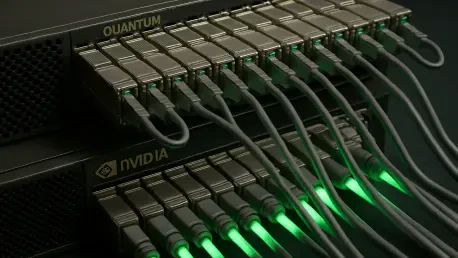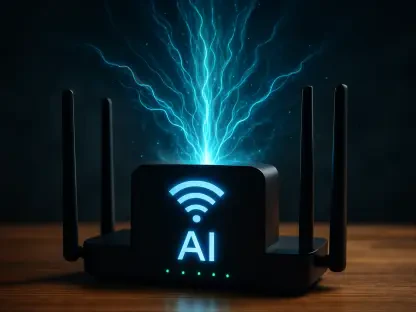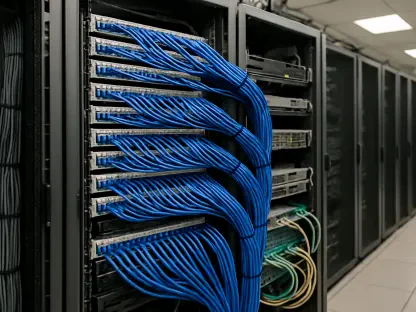In an era where computational demands are skyrocketing, the quest for groundbreaking solutions has led to a pivotal moment in technology: the integration of quantum and classical systems to solve problems once deemed intractable. At the heart of this revolution stands Nvidia, a titan in high-performance computing, which has unveiled its latest innovation in quantum interconnects at the SC25 Supercomputing Conference in St. Louis, Missouri. This development promises to redefine how complex challenges in science and industry are tackled, sparking curiosity about whether hybrid computing could be the key to unlocking unprecedented computational power.
Diving into NVQLink: The Backbone of Quantum-Classical Integration
Nvidia’s NVQLink represents a bold step forward, extending the company’s established NVLink technology to create a seamless bridge between GPUs and quantum processing units (QPUs). This interconnect facilitates direct communication, enabling GPUs to manage critical quantum computing tasks such as control mechanisms and error correction with remarkable efficiency. The performance metrics are striking, boasting a GPU-QPU throughput of 400 Gb/s and latency under four microseconds, setting a high standard for hybrid system interactions.
Beyond raw numbers, NVQLink addresses a fundamental bottleneck in quantum computing by leveraging GPU computational power to stabilize and optimize quantum operations. This synergy is essential for practical applications, as quantum systems alone often struggle with maintaining coherence and accuracy. Nvidia’s approach demonstrates a pragmatic focus on making quantum technology usable in real-world scenarios through robust integration with classical infrastructure.
CUDA-Programming the Future of Hybrid Applications
Complementing NVQLink is CUDA-Q, Nvidia’s innovative programming model designed to harmonize QPUs, GPUs, and CPUs within a single application framework. This platform empowers developers to craft hybrid quantum-classical algorithms, where traditional computing handles optimization and error management while quantum units tackle specialized computations. CUDA-Q’s flexibility is a cornerstone for building scalable solutions that can evolve as quantum hardware matures.
The significance of CUDA-Q lies in its ability to lower the barrier for developers entering the quantum space. By providing a familiar programming environment adapted from Nvidia’s CUDA platform, it enables a smoother transition for those accustomed to classical computing paradigms. This strategic design choice could accelerate the adoption of hybrid systems across various industries, fostering innovation in algorithm development.
Industry Trends and Nvidia’s Forward-Thinking Vision
The broader landscape of supercomputing is increasingly leaning toward quantum integration, a trend Nvidia is keenly capitalizing on. Dion Harris, senior director of HPC and AI infrastructure solutions at Nvidia, has emphasized that quantum processors will eventually become a staple in every supercomputer, while classical systems will remain indispensable for operational precision. This perspective underscores a symbiotic future where both technologies coexist to expand computational horizons.
Current industry dynamics reveal a reliance on cloud-based quantum services from providers such as D-Wave, Rigetti, IONQ, and AWS, highlighting the absence of commercially available quantum hardware. Nvidia’s proactive stance in developing interconnects like NVQLink positions the company as a leader in preparing for a time when quantum processors are mainstream. This forward-looking strategy aligns with the growing consensus among tech giants that hybrid architectures are inevitable.
Collaborative Powerhouses and Real-World Impact
Nvidia’s collaboration with Quantinuum exemplifies the practical potential of its quantum interconnects, integrating NVQLink with the Helios quantum processor to deliver an impressive 40 petaflops of AI capability at FP4 precision. This partnership showcases how hybrid systems can push the boundaries of computational performance, offering a glimpse into future applications in artificial intelligence and beyond. Such achievements signal a transformative shift in processing power for data-intensive tasks.
Globally, Nvidia has forged alliances with leading institutions and national laboratories, including Los Alamos, MIT, and Oak Ridge in the United States, alongside centers in Japan, Korea, Europe, and the Middle East. These partnerships reflect a shared vision for hybrid computing to revolutionize scientific research, cryptography, and materials science. The widespread interest from diverse regions underscores the universal appeal and urgency of advancing quantum-classical integration for solving pressing global challenges.
Navigating Challenges in Quantum Interconnect Development
Despite the promise of NVQLink and CUDA-Q, significant hurdles remain in the realm of quantum computing. The lack of market-ready quantum processors means that current implementations depend heavily on cloud-based solutions, limiting accessibility and scalability. Nvidia’s technologies aim to mitigate these constraints, but the path to widespread adoption is fraught with technical and logistical complexities that require sustained innovation.
Error correction and system scalability stand out as persistent technical challenges in quantum hardware. While NVQLink leverages GPU power to address some of these issues, the inherent fragility of quantum states continues to pose difficulties. Additionally, market and regulatory barriers could slow the integration of hybrid systems into mainstream computing, necessitating strategic planning and collaboration across sectors to overcome these obstacles.
Looking Ahead: The Trajectory of Nvidia’s Quantum Ambitions
The future of Nvidia’s quantum interconnect strategy appears poised for significant impact, potentially reshaping the supercomputing landscape over the coming years. Anticipated advancements in quantum hardware, coupled with refined software integration through platforms like CUDA-Q, could lead to breakthroughs in hybrid system efficiency. This trajectory suggests a rapid evolution of capabilities that might redefine computational benchmarks.
Industries such as AI, cryptography, and materials science stand to benefit immensely from these developments, as hybrid systems unlock new methodologies for problem-solving. Nvidia’s commitment to fostering global research partnerships further amplifies the potential for widespread innovation. As quantum technology matures, the company’s early investments in interconnects could cement its role as a pivotal player in this transformative field.
Final Reflections on Nvidia’s Quantum Journey
Looking back, Nvidia’s venture into quantum interconnects with NVQLink and CUDA-Q marked a significant milestone in bridging the gap between quantum and classical computing paradigms. The strategic collaborations with global research entities have laid a solid foundation for exploring hybrid applications. The impressive performance metrics and programming innovations stand as testaments to the company’s dedication to pushing technological boundaries.
Moving forward, stakeholders should prioritize addressing the technical limitations of quantum hardware through continued investment in error correction and scalability solutions. Governments and industry leaders ought to streamline regulatory frameworks to facilitate the adoption of hybrid systems. As Nvidia and its partners chart the next steps, fostering an ecosystem of open innovation will be crucial to realizing the full potential of quantum-classical integration in solving humanity’s most complex challenges.









